Instructions for planting Rogers outdoors and further care for it
Rogersia is a perennial flower often found in flower beds and gardens. This is an ornamental plant from the Kamlelomkov family. It is found in the wild in the East Asian region and in the Himalayas. Let's talk about how Rogers is grown, how to plant and care for it in the open field, in more detail.
What is this plant, what does it look like
Rogersia is a herbaceous flower with large green leaves of varying degrees of intensity and long, thickened, scaly rhizomes. Leaves are palmate or pinnately compound, attached to elongated petioles. The roots grow and soon after planting cover most of the surrounding surface, sometimes interfering with the development of other plants.
Flowers are small, gathered in panicles. Most often, the flowers do not have petals, but sometimes from 1 to 5 poorly developed petals are present. Sepals are colored white, pink, or red. Blooms in summer, closer to mid-July. Flowering lasts 4-5 weeks. Flowers smell fragrant, attracting many insects to the plant.
Important! After setting the panicles, shoot growth is activated. During this period, it needs to be watered more, if necessary, feed.
Features of growing Rogers in the open field
Rogersia gardeners are not considered a particularly capricious plant, but when planning to grow it in the garden, you will have to take into account the following features of this flower:
- the main thing is to choose the right landing site (if the site is suitable, then exotic rogers will delight with fragrant flowers and decorative leaves for a very long time);
- the roots stick to the surface, they should not be buried (maximum depth 5 cm);
- the soil must be nutritious, otherwise the plant will have to be constantly fed (exotic flowers prefer light gummy soils);
- there should be at least 1.2-1.5 meters between the Rogers and the rest of the plants in the garden (the flower grows quickly).
Roots need a lot of space, therefore, when planning to plant a Rogers, it is extremely important to correctly estimate the size of the site. It will not work to squeeze a flower between the fence and several rose bushes, it simply will not grow, which means that its decorative qualities will be lost.
Optimal conditions for Rogers
Rogersia loves moisture and warmth, nevertheless, it is almost a tropical plant, therefore, when planting it, special attention is paid to regular watering, the air temperature in the region. It is quite simple to create optimal conditions for growing, for this:
- Rogersia bush is slightly shaded artificially (with the help of a trellis with a cloth stretched over it) or with the help of other plants planted nearby (no closer than 0.8 m) and giving good shade (leave the flower under the scorching sun rays, especially in the hot summer months , it is impossible, he will get sick and may die);
- watered regularly with warm, settled water (the bushes are moisture-loving, they need to be watered at least 2 times a week);
- the humidity should be moderate, if the summer is often rainy, then the bottom of the pit must be covered with a dense layer of drainage before planting.
Rogers tolerates cold well, but if winter is expected to be frosty, it is best to cover the plant with old clothes, spruce branches.
Important! The optimum air temperature is +25 degrees Celsius.
Variety selection
Among experienced gardeners, the following varieties of Rogers are popular:
- Rogers is horse chestnut. The name of the variety is associated with the shape of the leaves, they, like chestnut, are connected only at the stem. This is a large plant, up to 1 m in height. In summer, the leaves are colored green, but towards autumn they become crimson. The flowers are unremarkable - white, small, collected in tall, but not at all lush panicles.
- Feathery. The leaves of this variety are dark green in the center and burgundy at the edges, elongated. The panicles are large, lush, the flowers are light and sometimes dark pink. To decorate any garden, such varieties of Rogers as "Fireworks" and "Chocolate" are suitable. The variety "Bronze Peak" is distinguished from the rest by the burgundy leaves. Rogers Elegance throws out tall, lush panicles of a milky shade.
- Stoopoly. This variety of Rogers is loved for its huge bronze leaves that cover the entire earth with a dense carpet. The plant prefers shade or partial shade, so it can be planted where other flowers do not like to grow.
- Henrici. The leaves of this variety are similar to ivy. The flowers are small, but very beautiful, usually of a delicate pink hue. The cultivar "Cherry Blush" is especially popular among gardeners.
When choosing a specific type of Rogers, they are guided by personal taste and whether this ornamental plant will be combined with those that already grow in the garden. If the site is well lit and it is simply impossible to find a dark or shaded place, then select the Rogers variety that can tolerate direct sunlight well.
Landing dates
The plant can be planted in the garden in spring or autumn before frost or after their retreat. Autumn planting is more preferable, since the plant that has survived the cold grows faster with young leaves, blooms more luxuriantly.
Plants planted in spring often suffer from bad weather conditions (rains, thunderstorms, summer drought), they need more time to get stronger, so they start to delight with lush flowering or a beautiful shade of foliage only in the second year.
Important! Rogers reaches a real exchange in the third year after disembarkation, stretching 1.5 meters in height and growing by 0.5-08 meters in width.
Landing
The plant is planted in a prepared, fertilized and watered soil in advance. The root system is powerful, so it is almost impossible to damage it, you can act boldly. The main thing is to choose the right place for planting and make sure that the young plant is healthy (it is not recommended to transplant infected flowers).
Seat selection
Rogersia loves shade and partial shade. Planting it in an area open to sunlight will lead to a change in the natural shade of the leaves, they can burn, become covered with unpleasant brown spots, and even fade.
Ideally, the flower is planted in a shaded corner of the garden, protected not only from the sun, but also from the wind. It should not be a lowland, in this case there is a risk of rotting of the root system, or an unprotected hillock. An equal part of the site will do, protected from the sun and wind from all sides by other plants.
Important! If the groundwater is located closer than at a distance of 1.5 meters, then the site is drained before planting the Rogers.
Preparation of soil, planting material
The plant prefers light fertile soils, abundantly flavored with humus, peat or compost. It is allowed to replace the soil removed from the pit for planting with earth obtained in the forest or under deciduous trees in the garden.
To keep moisture in the soil longer, it is mulched abundantly using sawdust, straw, leaves, peat, chopped pine cones and even small gravel.
Planting instructions
When boarding, follow simple instructions:
- the pit is prepared in advance, the bottom is covered with drainage (sand and crushed brick chips), on top of which humus or peat is poured;
- the seedling is removed from the container in which it grew before;
- a young bush is placed in a hole, deepening no more than 10 cm (ideally 5-6 cm);
- sprinkle on top with fertile soil;
- tamp the soil under the bush;
- watered.
If necessary, mulching is carried out immediately, using, among other things, chopped bark, previously doused with boiling water in order to destroy the pests that have settled in it.
Outdoor Rogers care
Caring for Rogers is easy enough. It can grow even in very difficult conditions, to the detriment of decorative elements, which should not be allowed.
Watering
Water often. If the summer is dry, then every evening, if it rains, then after checking the soil for moisture (it is enough to stick a pointed branch into the soil under the bush, if you enter easily and stretch out with traces of earth, then you will have to wait a little with watering).
Top dressing
They are constantly fed. They use both mineral and organic fertilizers. For abundant flowering and the acquisition of leaves of a beautiful color, the soil is regularly flavored with complex mixtures in which nitrogen, potassium and phosphorus are present. Top dressing can be combined with watering.
Pruning
Pruning is done for sanitary purposes (remove dry leaves as they appear). Closer to autumn, after the flower stalks with seeds appear in place, they are cut off, leaving only a few, if it is necessary to obtain planting material. In late autumn, all shoots are cut at the root.
Protection against diseases and pests
Rogersia is considered a plant that is not afraid of pests or diseases. But this is not entirely true, gardeners should be wary of snails and slugs. They damage leaves and even roots, which often leads to the death of the plant. To get rid of pests:
- damaged foliage is removed;
- the remaining parts of the plant are treated with fungicides or soapy water.
Processing is carried out carefully, the substance should not get on healthy plants that are not infected with slugs. It is better to purchase a special poison for snails and slugs in a specialized store.
Preparation for wintering
If the winter is expected with little snow and very frosty, then the plants are covered for the winter. For this purpose, use:
- non-woven fabric;
- plastic wrap;
- old clothes;
- dry leaves;
- straw;
- fir branches.
They are sheltered just before frosts, around the end of September or November, it all depends on the region.
Reproduction
Rogers is propagated by:
- Seeds. Germination is poor, this method is chosen only by very patient growers. Seeds are sown in the ground at the end of February. They are simply scattered over the surface. The seed pot is covered with a film, placed in a warm place and watered periodically. As soon as the first shoots appear, the film is removed. Landing in the garden is carried out after the temperature outside the window rises to +15 degrees.
- Cuttings. The main advantage of this propagation method is that young plants can be obtained in summer as well. For this, several strong cuttings are cut from the bush and placed in a container with water or a nutrient mixture for rooting. As soon as the first roots appear, the plant is planted in a pot, where it grows until September. In autumn, a young bush is planted in open ground.
- By dividing the bush. The flower is uprooted, then the bush is divided into several parts. At the same time, at least a few buds should remain on each rhizome. The resulting compact bushes are planted in different holes at a distance of 0.5-1 m from each other. You can divide the bush both in spring and autumn, before frost.
Important! Already strengthened plants with 3-4 leaves are planted in open ground.
Reviews
- “Rogersia has been growing in the garden for five years in a row, I can't get enough of it. I planted it in the darkest corner, not a single plant had grown there before, but it took root and became an adornment of my summer cottage ", - Ekaterina Pavlovna
- “I saw this flower at a neighbor's house and could not help but beg a small bush in the fall for my own plot. The planting took place without any problems, I was afraid that the plant would die in winter, but the frosts passed, and the whole summer I was pleased with the beautiful rogers ”, - Petr Borisovich
Rogersia is a guest from the tropics, an exotic plant that has successfully taken root in summer cottages, is used to decorate flower beds, and becomes part of bouquets. It is simple to care for a flower, it loves moisture and shade, with frequent watering and feeding, it pleases not only with abundant flowering, but also with beautiful leaves. Most growers speak of Rogers only positively.
A story about Rogers from a grower in the video:



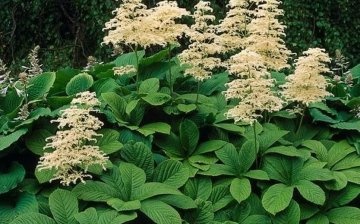
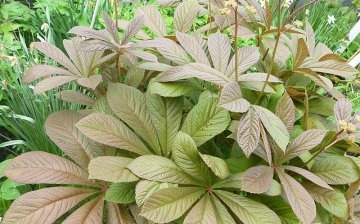
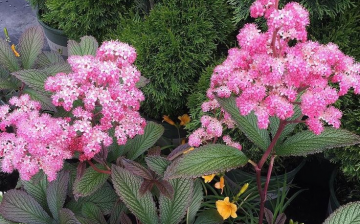



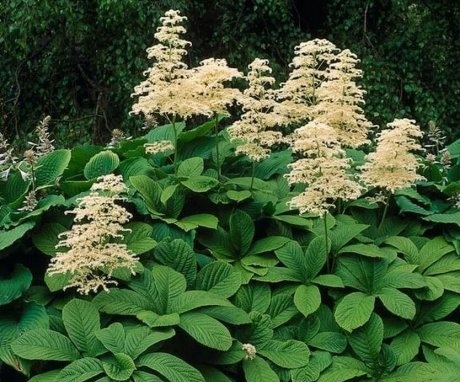
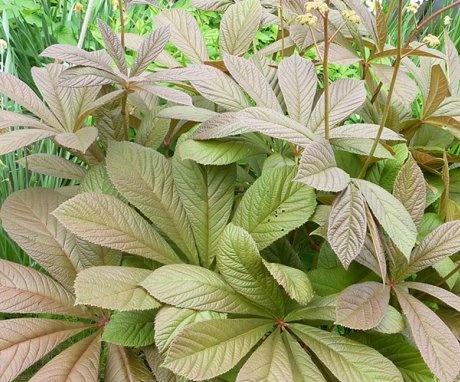

A very beautiful flower, only requiring good care, otherwise the plant will wither. I didn't like the fact that Rogers likes high humidity. In addition, the flower needs to be pruned and fertilized.
Rogersia came to me not so long ago, you know, picking flowers on the shady side is not so easy. In general, I threw away the fern that grew between several hosts (also a great solution for shade) and planted a Rogers. Took a hundred-leaf Braunlaub. A gorgeous plant, height of about 1 meter, bright bronze leaves with a brownish tint, looks very elegant in autumn. Leaving ... I would say minimal. And no special conditions are required.